
In this section, we shed a spotlight on brands that hold marketing lessons for both entrepreneurs and brand custodians. Consider a category where just getting the requisite licenses to launch your product is a huge task. You have to abide by a stringent set of policies and regulations that differ across States. Online sales are mostly banned, offline outlets are limited in number and reigning players come with globally recognized brands, deep pockets, and are extremely protective of their turf. And to top it all, the brand in our spotlight is on an audacious mission to establish a completely new category in this space.
We are talking about Moonshine Meadery- an alco-bev startup based out of Pune, co-founded by childhood friends Rohan Rehani and Nitin Vishwas, who also happen to be passionate homebrewers.

What is mead and why the name Moonshine?
Mead is a gluten-free alcoholic beverage made by fermenting honey with various fruits and spices.
The name of the brand, Moonshine, has an interesting backstory. Although the word moonshine existed for quite a while, it became popular during the Prohibition era in the US. Illegal distilling of whiskey happened by moonlight, and then expert drivers smuggled the spirit across borders, relying only on moonlight for illumination. And the spirit thus distilled and smuggled came to be known as moonshine.
When Rohan and Nitin started brewing their first batches of mead, their friends and family were confused about what they were doing. Worried that they were brewing illicit ‘moonshine’ liquor, they advised them to stop. As a matter of fact, that’s where the name of the brand came from!
The Inspiration and early beginnings
It all started when Nitin chanced upon the concept of mead in an inflight magazine during one of his many European flights as a jet setting consultant. He felt the category represented a white space in the Indian AlcoBev industry. He shared this with his childhood friend Rohan, and they both decided to experiment with brewing mead in small batches. Soon their passion turned serious, and they started Moonshine Meadery to make and sell mead.

Taking the first bite- teething troubles
Alco-bev category in India is very tough to break into. Legacy behemoths use armies of lawyers and consultants to navigate registration and bureaucracy hurdles. With limited outlets and a ban on most online sales, this is a constrained distribution business. Carving out a new category in the alco-bev space where distribution and communication both are severely constrained can give nightmares to even experienced players.
But where experience breeds hesitation, innocence can drive action.
Constrained by resources and regulation, Rohan and Nitin started slow. In fact, Rohan left his cushy and comfortable job to spend close to a year waiting outside the excise department office, trying to get the permit papers moving, and then Nitin and Rohan built most of the fermenting plant literally by hand, consulting YouTube videos for guidance. This ‘getting your hands dirty’ value is something that Rohan and Nitin cultivate in their team as well. “Even now, whoever joins Moonshine begins by brewing a batch,” explains Nitin.
Clarifying the category before building the Brand: “Mead is not Beer”
“Unlike beer, mead is not bitter, it’s better,” explains Rohan. A funny incident that happened when Rohan and Nitin participated in a competition at Mumbai’s Mahalakshmi racecourse with seven other breweries underscored consumers’ difficulty in slotting mead into its own category. Despite Moonshine Meadery neither being a brewery nor brewing beer, they won the best brewery and the best innovative beer awards. They also won the second-best beer prize! Hence, even before the team took the first steps towards marketing their product, they realized that to make a scalable impact beyond their immediate circle- with whom they had the luxury to explain their product- they would need to bake category education into their marketing mix.

Some early moves that helped them get it right:
A simple yet effective flavour philosophy
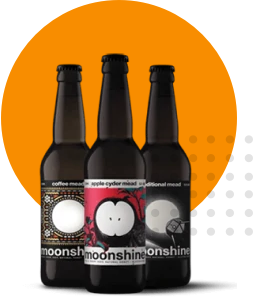
“What You See is What You Get”: while it’s easy to delve into the exotic credentials of mead and present it as a connoisseur’s choice, the founders knew that this wouldn’t help them build scale. The intent was to ensure that consumers needn’t be connoisseurs with trained palettes to enjoy a Moonshine mead and identify its flavours.
Hence, Rohan and Nitin went on to introduce flavours like chilli and guava, coffee, pineapple, etc. that are easy to understand for consumers and where they could ensure that the liquid lives up to both flavour perception and promise.
Each new variant of mead goes through multiple rounds of iteration both within the company and with potential target consumers. This approach of building products in public and iteratively is something that new-age brands are increasingly employing.
Capturing the right need-state

Alcohol brands can tap into many need-states, ranging from very personal ones like winding down and reflecting to really social ones like celebrating and blending in. Given the easy-drinking nature of the brew and the choice of delicious flavours, Moonshine is positioned to cater to the need-state of “Refreshment”- a big need state, where consumers want something that can enable easy contemplation, casual conversations or friendly catchups. This opens up a wide range of occasions for the brand.
Zooming in on the right target audience

Rather than competing with alcohol brands (and beer), Moonshine intends to be the first beverage a discerning consumer would pick up in their journey from non-alcoholic to alcoholic drinks. Moonshine Meadery’s target consumers are therefore in the 21-35 yr age group, and almost equally split between men and women. These consumers are looking to graduate from sugar laden colas to alcoholic beverages but don’t want to settle for a bitter taste. For this young demographic looking for a young brand with the right badging value, Moonshine fits the bill.
Marketing that doubles up as category education

Finally, when it comes to marketing, the brand deliberately decided to keep things simple yet provocative. This is succinctly captured in the brand’s ad line that goes on its multipacks as well as in-store branding- “Mead is not Beer”- a great move to both establish, educate and own the new category!

Crafting a Brand by thinking “Brand First” at all touchpoints
With passionate founders working in a category where craft symbolizes freshness and connotes great quality, Moonshine made some remarkable moves that hold lessons in building brands for new-age consumers:
Keeping it freshly consistent through creative collaborations
Unlike established brands that play by the traditional playbook of keeping packaging designs absolutely consistent, Moonshine took to the insurgent brands’ approach of keeping its label designs ‘freshly consistent.’ They achieved this by keeping few core elements of packaging fixed and inviting artists and designers to play around with the rest to suit the nature of the variant. This helped the brand to instigate curiosity and chatter among the right creative circles. The Kyoorius awards Moonshine won for brand re-design and best packaging is a testament to the success of this collaborative approach.

Constraints leading to creativity
Given that there’s a ban on explicit advertising in the alco bev category, Moonshine Meadery has turned to innovative methods to drive awareness. While artist collaborations drive social media chatter and word of mouth for Moonshine’s packaging, the brand also uses honey, its key ingredient, to offer a strong reason to believe in its quality credentials. The moonshine Honey Project is their initiative to support local beekeepers as well as educate consumers about the quality and authenticity of the honey they use to brew their meads.
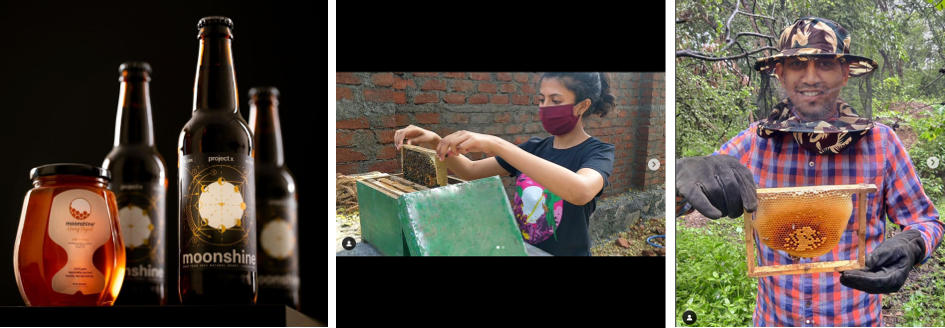
Keeping the conversations Human
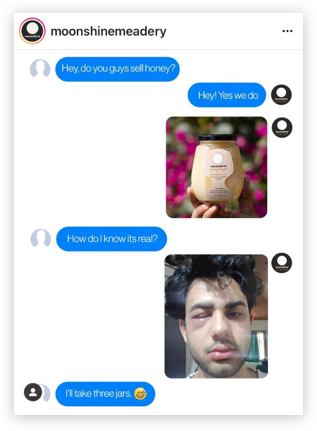
The young brand team at Moonshine Meadery handle their social media by themselves, without any external agency. This keeps the brand real and human, with even the odd mistakes in posts serving to highlight the human side of the brand. A classic example was when a consumer asked for proof of the quality of their honey. The brand responded by posting a picture of an employee accidentally stung by bees in the process of honey collection! Responses like these exemplify the brand’s intelligent moves at striking conversations that differentiate it from incumbents. When the brand launched in Bangalore, Nitin, accompanied by the brand manager, hand delivered multi-packs of mead to fans of Moonshine in Bangalore who had hounded the brand about Bangalore launch dates on social media. In the early stages of brand building, initiatives like this, even though they are not scalable, can help you build a strong set of super-fans.
Sampling as a route to trials, repeats and Word-of-mouth
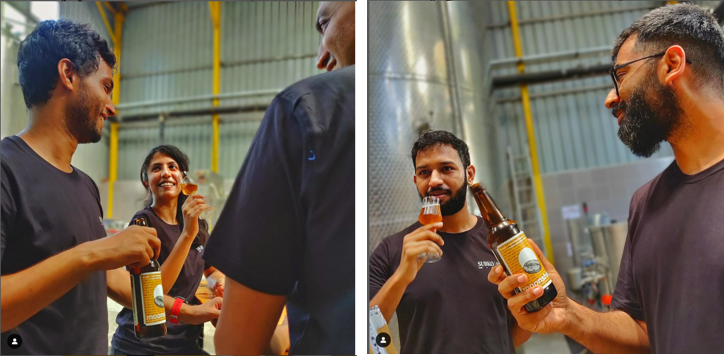
Alco-bev category, despite many constraints, also has an advantage. It’s the only category where a brand can make consumers sample its product in the right setting at the place of consumption like a pub or a bar. Confident of their product, the team made the most of this by extensively driving sampling, at both on and off-premise. The sampling drive kickstarted organic repeats, boosting the team’s confidence. “Sampling is one of the best forms of marketing in this category,” stresses Nitin.
Leveraging Distribution to build emotional affinity
Moonshine spotted and exploited another unique opportunity in the Alco-Bev category. When consumers sample a brand at a holiday destination like Goa, they tend to build an emotional affinity and it becomes a way to relive their cherished holiday moments when they are back in their city. Hence, beyond major metros, Moonshine went on to place its products in hot tourist destinations buzzing with travellers from adjacent markets. This gave Moonshine both trials and recall, providing tailwinds to its sales in home markets.
The power of complementary founding team
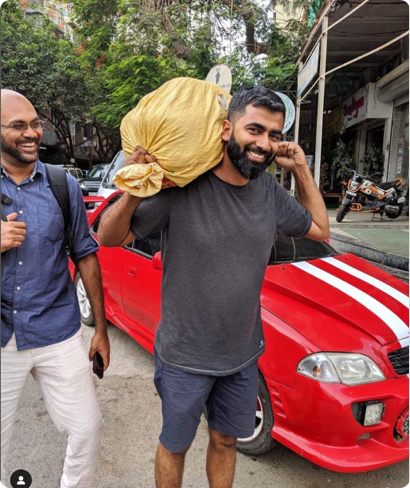
Despite being childhood friends and sharing similar tastes in many things ranging from music to meads, Rohan and Nitin bring complementary skills to the table. “Rohan is the dreamer while I’m the guy who worries about the business,” says Nitin, clarifying how they have divided the work between themselves.
Bringing together the power of analytics and creativity helped the team steer clear of echo chambers in its early days and take dispassionate decisions devoid of cognitive biases- a blessing when entrepreneurs are building an entire organization ground-up.
Incubating “Brand Culture” in the organization
Aligned to its target audience, Nitin and Rohan have also built a small but dedicated team.
“The average age of our team is about 25. We have a flat, and sometimes even an inverted hierarchy,” jokes Nitin. The founders allow them total flexibility in taking important calls related to branding and design. The idea of collaboration is so steeped in the brand’s culture that even their interactions with creative partners feel more like a jamming session of ideas.
Challenges & Learning- Pandemic and beyond…
While it seems logical to open-up distribution state wise in adjacent markets, this proved a bit counterproductive for Moonshine. During unexpected events like a pandemic, if one state closes, the neighbouring state follows suit soon after. To counter this, the founders have now spread their distribution to 7 states, and want to be open for business in 8 by the end of January 2022. Eventually, Rohan and Nitin dream of going global with Moonshine.
Scaling up quickly can be complicated in the alco-bev category where laws and regulations vary from state to state. Further, each state requires going through its own process of licensing and registration, as well as negotiating with powerful distributors. That’s where the team’s philosophy of ‘getting your hands dirty’ is likely to prove handy. Further, at a price range of Rs. 185/- to Rs. 250/- for a pint (depending on the State), Moonshine meads are not exactly cheap. This can be a hindrance to throughput and the team needs to constantly work on innovative methods of brand building to catch the eye of both consumers as well as trade.
Despite early success, category creation is always tough. The majority of the user base for most innovative products will be early adopters. However, grabbing a meaningful category size will require going beyond these early adopters and driving mass consumption. It remains to be seen if Moonshine Meadery can crack this equation, especially because they will need to drive consumer education in a category where consumers are often simply looking to have a good time.
Our Take:
From a passion project that started with home brewing to a fast growing brand that’s winning awards and palettes, Moonshine has come a long way in the last few years. Their ideals of Fresh Consistency, Constraints leading to Creativity, Co-Creating with Consumers, Keeping the Brand Human and above all, a collaborative approach to brand building holds valuable lessons for new-age brand builders.
Cheers to them and we wish them loads of luck!

